Car Safety Tips during Vacation


The number of accidents increases during vacation time. This is due to more traffic being on the roads and more vacationers prefer riding a car going to their destinations. In 2007, over half a million accidents with about 123,000 casualties occurred during the main vacation months.
The number of accidents increases during vacation time. This is due to more traffic being on the roads and more vacationers prefer riding a car going to their destinations. In 2007, over half a million accidents with about 123,000 casualties occurred during the main vacation months.
Further study has shown that vacationers are once again using the car more frequently as means of transportation. Whereas only 29% of those traveling in 1993 went by car, in 2007 it increases drastically to 45%. In particular families with children are turning to the car according to the study - roughly 47% of them will be driving. Car tourism is enjoying a revival as a symbol of spontaneous and individual traveling that is reasonably priced and ensures freedom of movement.
But before going to vacation by car, please take a look of these safety precautions that might help you cope-up and make your vacation a safer one.
Before starting off on vacation, pay attention to your health. Any individual will encounter a one hundred to zero due to extreme stress. But pay close attention to your car as well.
The increased weight and the shift in the center of gravity of a fully-packed car change the steering and handling performance as well as the braking reactions. Whoever does not adapt their driving style accordingly can quickly lose control of the vehicle in precarious situations. Unfamiliar stretches represent an additional risk, especially if the driver's concentration wavers. Make sure to take breaks regularly - about once every two hours.
That is why it is important to inspect the car before departing on vacation. It's vital that you adjust tire pressures to comply with vehicle manufacturer recommendations before setting off, since insufficient inflation pressure means faster tire wear, higher fuel consumption, and longer braking distances. People who check their tire pressure regularly are doing themselves and the environment a favor.
Before the journey starts, it is important that the tires are also inspected for signs of damage, and to ensure that they have sufficient tread depth. If damage is detected, or even merely suspected, a tire specialist should in any case be consulted for advice. Summer tires should be renewed once the tread depth has worn down to three millimeters. If the tires have less tread than that, they should be replaced to be on the safe side. Brake fluid should also be checked prior to starting the vacation. As far as the depth of tread is concerned, if the fluid level has dropped considerably, one should definitely inquire at the auto repair shop about possible causes.
Garages provide assistance with the pre-vacation check. They inspect the tires, brake system and chassis, and remedy any faults in good time beforehand. A fully loaded car also poses a risk. This leads to changes in the center of gravity and vehicle handling.
Make sure you distribute your luggage evenly so that nothing can fly about in the vehicle if you crash or need to brake sharply. In a situation like that, unsecured items can quickly turn into deathly missiles. What's more, exceeding the maximum total weight specified by the vehicle manufacturer could result in a fine and penalty points.
Ten Important Vacation Tips:
1. As already mentioned, the tread of your summer tires should have a depth of at least 3 millimeter.
2. In the case of tire failure, you should have a mobility kit. With a mixture of air and sealant, the breakdown set restores mobility quickly and easily, so you can continue driving to the workshop or a safe parking space.
3. High Pollen count can affect driving concentration. When the temperature is up, the pollen count is frequently also up. One plant or another is always in bloom, exacerbating allergies. For many sufferers it's a matter of choosing between sneezing attacks and runny eyes, or prescription drugs that tend to bring on drowsiness. Any of these has the effect of reducing one's concentration - and that can be very dangerous when driving.
Allergic persons exhibit a 30% higher risk of getting involved in an accident. Drugs that don't cause drowsiness should be opted for wherever possible, provided they do not conflict with what the personal physician has recommended.
4. Avoid getting behind the wheel in the event of severe allergic reactions, or at least pull over whenever a violent attack occurs.
5. Keep the windows and the sliding roof closed when driving to reduce the pollen count in the vehicle .Turn off the ventilation; but don't switch to recirculation mode for a long time as this will steam up the windows.
6. Install a pollen filter or, even better, a combi filter, which also keeps exhaust out of the passenger compartment in addition to pollen, soot and dust.
7. Replace the filter at regular intervals (once a year).
8. Wear sunglasses to relieve eye exertion.
9. Set the air conditioner to 'cool' as this relieves the symptoms.
10. And, as a final tip from the experts: "Do not hit the road in a state of after-work stress. Make sure you are fresh and rested, as this makes things safer for you and for other road users."
note: originally posted at Exposeknowledge.com under the same author.
Cars are already an essential part of human need and luxury. Designing cars of the future remains one of the preoccupations for all designers, and yet few dare to advance their imagination beyond a few decades.
Read all relevant facts about this beautiful hypercar, and one of the first who will know what to expect..
Coverage of weekly Car Show and Oldies Groove at Bobo's Cafe in Somers, NY.